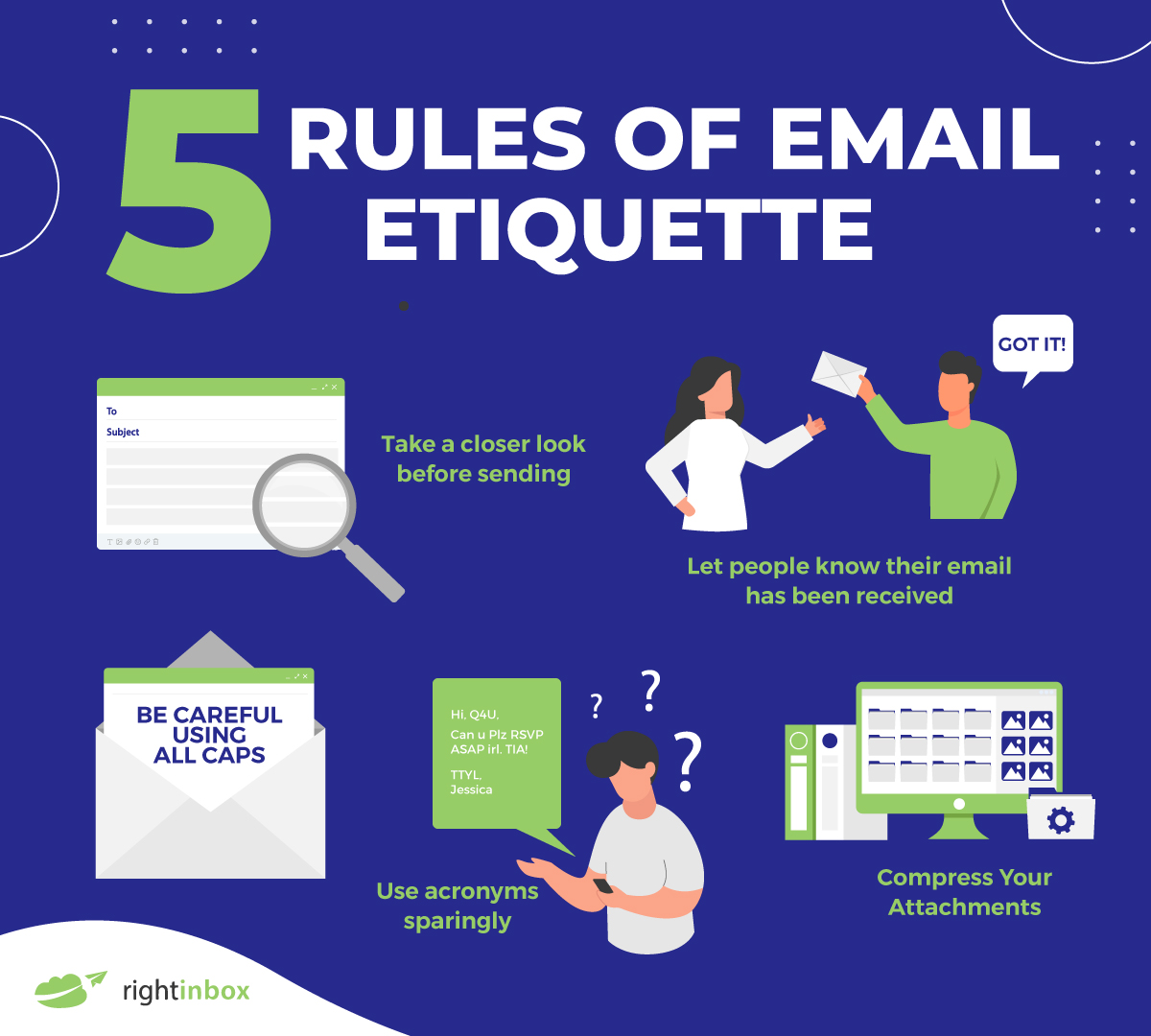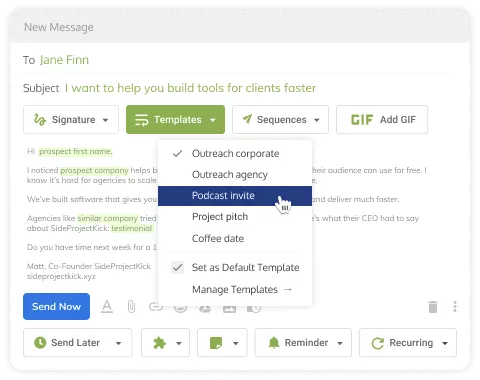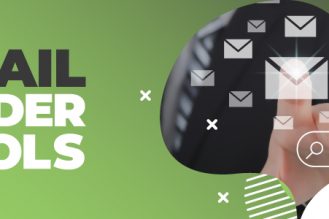Whether working as the head of communications or sending Grandma updates about a trip to Paris, most of us will use email regularly. But there is a huge difference between sending a customer a professional onboarding email and emailing a silly snap of yourself by the Eiffel Tower.
When writing an informal email to friends and family, you can usually put in whatever you want (well, to a point anyway). You can add photos, make a joke, and they probably won’t mind any spelling mistakes.
However, writing a formal message has completely different email etiquette.
Like anything in communications, the point of emails is to get someone’s attention, and to get some kind of response. That response might be a click-through to a website, or a direct reply. Crafting the perfect email is the best way to get the response you want .
So, whether you’re starting out in email marketing, looking for tips on emailing recruiters, or you just want to appear professional, here are some pointers on how to write a formal email.

Writing a Formal Email Best Practices
We’ll look through many aspects of emails in depth, but let’s start with a quick list of best practices to bear in mind:
- Make sure that you have a professional email address. Sending a message from a.smith@[example].com looks far better than iluvcutecatsxxlol@[example].com.
- Check how the person you’re emailing prefers to be referred to – don’t call them Mrs, if they’re a Dr, for instance.
- Avoid ALL CAPS text
- Don’t send attachments that haven’t been requested
- If you’re sending it to multiple people, use blind carbon copy (BCC), not carbon copy (CC) to avoid data issues
- Don’t use reply all unless everyone in the email needs a response
- Use standard fonts
- Proofread before sending
No matter who you’re sending it to, these best practices are key to keeping your email professional. Of course, there’s more to it than that – let’s take a look in detail at aspects to consider.
1. Consider The Tone
When writing a formal email it’s important to consider the tone throughout. You need to be more serious than you would normally be when sending a message to friends and family.
This means not making any jokes, using slang, or emojis. Definitely no cursing. You may have the best intention and are trying to be friendly, but it can come across as unprofessional.
That means you want to avoid emails that look like this:
Hi Y’all,
I saw an ad for your company on insta and it’s lit! :P I’m an influencer and can make your company BIG!! IF you wanna make $$$ hit me back.
Over and out
PEACE xxx :) :)
Although this is a generally upbeat and positive email, it reeks of unprofessionalism. Firstly, it doesn’t really make much sense. Secondly, there isn’t really much detail in there of why the person is messaging.
Keeping a formal tone means not writing how you might speak, making the objective clear and writing words in full (want to, not wanna).
Put yourself in the recipient’s shoes. Always consider the role of the person you are writing to and the tone you think will make them take you more seriously. Remember that we often write things differently to the way we say things. Since you’re not having a face-to-face conversation, there are no body language cues to rely on – so the tone needs to be clear and professional.
2. The Subject Line
Of course, all this goes to waste if people don’t open your email. We all get those junk emails that we delete before even opening. You don’t want to get caught up in this. What you do want to do is entice them to open the message and give them a taste of what is inside.
Say you are applying for a job as a social media expert for an eCommerce company.
Here is what a subject line should NOT look like:
“FACEBOOK!!! TWITTER!! INSTGRM!! I am the on 4 YOU!!!”
Okay, the capitals might catch the reader’s attention. Unfortunately, it will probably catch their attention in a bad way. Combined with informal writing and spelling mistakes, it will most likely just get deleted before it’s ever opened.
A better subject line with a more appropriate tone looks like this:
“Social Media Expert application at (Company Name)”
This instantly shows why you are emailing them. Including the company name also makes it clear the message is specifically for them. Think about who your audience is and what you want from them.

Source: Design Taxi
3. Use an Appropriate Greeting
It can be easy to slip informalities into an email without even noticing. Greetings are the most common place for this. But using greetings such as “Hiya”, “Yo!” or “What’s up?” should be saved for friends and family.
When talking to a professional, it’s important to know how to start an email properly. This will help set the tone for the rest of the email. Again, it’s all about being taken seriously and inviting people to read on.
A good way to start a formal email could be through using greetings like:
- Dear [name] – especially for very professional/traditional recipients
- Hi [name] – for a more formal greeting, use their title and surname here
- Greetings
- Hi everyone
While it’s commonly taught in school to address people as Sir/Madam, this is a little outdated today. Not only does this feel as though it’s a generic message, but not everyone wants to be known as Sir/Madam.
Ideally, research how they refer to themselves. If they mostly use their first name, then you’re safe sending something like ‘Hi Carol’. If they tend to use a title and surname, aim for something a little more formal, like ‘Dear Mr. Brown’.
Make sure to pay attention to their title and the spelling of their name. For instance, if you’re emailing someone called ‘Alexa Smith’ and you refer to her as Mr. Alex Smith, you’ve already lost her.
If you are really struggling to find a name, use a job title instead. For example, you could write ‘Hello to the Head of Communications’. This tends to be better than ‘to whom it may concern’, as it shows you have a specific person in mind.
4. Give an Introduction
Depending on who you are writing to, sometimes you might want to put in a friendly line to ‘break the ice’. This could be something along the lines of, “I hope you are enjoying the lovely weather.” Introductions like this just show that you come in peace and are friendly.
However, it should only be used at certain times, like if you are sending a follow up email or if perhaps you have spoken at some point in the past. If it’s your first communication, something a little more generic like ‘I hope this email finds you well’ might be better.
Otherwise, you can get straight into introducing yourself and why you are emailing. Try not to get into too much detail or blabber on about irrelevant details. People tend to skim messages and want to get to the point.
Here is an example of an email with a good introduction:
Hi Maria,
I’m Joy Palmers from the cloud contact center department of the Chicago Council and I am a big fan of the work you have been doing with DevOps.
I would love to talk to you more about collaborating on a big data project that will help take our wonderful city into the future. If this sounds of interest to you, let me know and we can book some time in to talk.
Thank you very much.
Kind regards,
Joy Palmers
Notice that this is quite a short message that gets to the point. It also uses positive language but still has a formal tone. It draws the reader in with being specific about what they want.
5. The Body
We’ve just looked at an example of what the body of an email could look like, but it’s not the only way to write one.
There are a few key points that you will need to keep in mind when writing the main bit of the email. The email needs to have a specific purpose and needs to be concise. If you are messaging somebody to set up a meeting, let them know. If you want to want to get feedback, put this in the message.
Whatever it is, tell them sooner rather than later.
As workplace digitization becomes more popular, everything is done at a faster pace. This includes reading through emails. Since people are likely to skim your message, you want to get your point in there in a few short lines.
If you have a lot of information to put in there, it might be worth using bullet points. Try not to squish all the information into one long paragraph. It makes it hard to read and key points end up getting missed out.
Here’s an example:
Dear Viktor,
I found a white paper you wrote on What is CCaaS online and noticed you run a call center job agency. My name is Grace Derwent, I am the CEO of a zero-waste start-up and as we grow, we need more staff.
We are looking for people specifically for the call center, which is why I thought you would be perfect.
Over the Christmas period we are looking to hire:
- 10 agents for the call center
- 3 managers
- 2 marketing managers
The workers would be needed between October 1st to January 31st.
How much would it cost per person per hour, please?
It would be great if we can find a way to work together.
Thank you.
Best wishes,
6. The Sign-Off
How you sign-off is just as important as how you greet someone. With a formal email, it needs to be a formal closure.
Phrases like “Bye!”, “I owe you” “Ciao for now” or “Cheers, buddy” should all be saved for people you know better.
A mistake that a lot of professionals make is to use the word “best” as a way of signing off. Although this is short for “best wishes” or “best regards”, it is actually more informal than people may realize – using the full phrase is far better.
Slightly less formal closings are okay when working with social media customer service messages. Saying, “Thank you, have a good one” is okay for Facebook. But unfortunately, these rules don’t apply with professional emails.
Some things you can say when closing an email are:
- Yours sincerely – if you’ve opened with ‘dear [name]’, this is the one to choose.
- Sincerely
- Thank you for your time
- Looking forward to hearing from you
- Kind regards
- Have a wonderful day
As time goes on and you have more back and forth with the person, emails will probably get more relaxed. Follow their lead with greetings and sign-offs – if they’re more informal, then you can be too. For the first one or two interactions at least, emails should stay prim and proper.
Of course, if you’re dealing with a serious topic, the formality should stay throughout, no matter how many emails have been sent. This is something you will be able to decide for yourself dependent on the context.

Source: Virtual Linda
7. Email Signature
Depending who you are emailing and what you are emailing them about, you might decide to use an email signature.
For example, if you are a junior digital marketer and you want to email someone about an outreach strategy, having an HTML email signature will show that you mean business.
As part of the signature, you should include:
- Your name
- Contact information (phone number and address)
- Job title
- Website and links to (relevant) social media
If you work for a company, somebody should be on hand to tell you how to do this. If you work for yourself, or simply want to send a one-off email, searching ‘email signature’ on your email account will let you create a custom one. Email signatures are great for an authoritative and professional tone when needed.
8. Proofread the Email
This may seem like an obvious point, but you’d be surprised how often people don’t read through the messages they send.
It’s easy to make several mistakes in emails without realizing it.
For example, if you are writing on behalf of a telecoms company and write, “I deal with posted PBF” instead of, “I deal with hosted PBX”, it can give your email a completely different meaning. It might even give off the impression that you don’t really know what you are talking about. And as a result, will just be ignored by the recipient.
To help look for any mistakes, run your email through writing or editing software that will highlight spelling or grammar points. Most browsers automatically have this in place, so make sure you pay attention to those red lines!
Proofreading is also a great way to make sure you’ve included everything you need to – after all, there’s nothing quite as informal as having to send a follow-up ‘oops!’ message.
9. Make a Template
Rather than having to stress that you are hitting every point each time (or keep re-reading this article), it may be worth making yourself an email template.
An example of a template may look like this:
Dear [Name],
[Say something special about that firm.] My name is [name], and I work for [company]. I’m contacting you because [reason why you want to reach out to them].
[Expand on the reason for contacting them. Add bullet points if needed].
Thank you for your time. I look forward to your response,
[Your name]
Signature.
Looking at a template in this form can be a little confusing. Here is what an email template might look like filled out:
Dear Mr. Farrell,
I have seen your firm advertised on television and I think it looks great. My name is Edwardo Sanchez and I work for the Miami Museum of Flowers.
We are looking for a marketer with your expertise and we are hoping you could help us out.
We are looking to:
- Gain more social media followers
- Sell more products online
- Encourage more people to visit the museum
If you are interested, please let me know and we can talk more.
Thank you and I look forward to your response,
Edwardo Sanchez
Curator, Miami Museum of Flowers
123-123-123
After creating a template, save it on a memory stick or computer if using something like Word. Otherwise, using the search bar, you should be able to write an email template on your online emails.
Many services offer customizable templates – often with visuals as well as text. Using images in formal emails can be a risky strategy, but if you’re writing marketing copy, they’re worth considering.

Once you have written a few formal emails, it will become second nature to you. Remember that you want to get people’s attention and get your point across, while still being taken seriously. This isn’t to say that you have to be over-the-top – just to keep in mind that being too informal won’t get you far when emailing people you don’t know.
Knowing how to conduct a formal email well can help you get further when it comes to contacting others. Properly written emails can help with anything from getting questions answered to dealing with complaints.
Now there’s just the matter of dealing with all the responses.
10. Get to the Facts
Obviously, humans are emotional beings and you are no different. One of the challenges of business, however, is keeping the conversation free of emotion. A formal email should address the objective facts and leave it at that.
So for instance, instead of using descriptive phrases like “giant mistake” or “failure”, you could talk about a missed objective in terms of numbers — “50% decline in revenue” or “$10 increase in cost per lead.” This helps conversation focus on the problem at hand.
11. Avoid Assumptions
When it comes to formal email writing, assumptions can do more harm than good. If you are unclear about something, it’s best to ask questions to clarify your understanding. By doing this, you ensure you’re addressing the real issue instead of appearing presumptions or unprofessional.
For example, if you are following up with a client that did not purchase your product yet, you should identify the reason why. Don’t assume with statements like “I know you preferred to go with another provider” before you know for certain that that’s the case. You could actually dig yourself in a deeper hole that way.
12. Stick With Professional Contact Methods
You or your company likely have official communication channels. These include email, a business phone line, or potentially other avenues. When a matter seems pressing, it might be tempting to communicate by other means. However, you should avoid this.
For example, don’t offer your personal cell phone number, or Facebook information. Firstly, this can come across as too informal and unprofessional. Secondly, there is a reason your company uses traditional communication lines — for quality assurance and organization. Getting too fancy can actually hurt your bottom line in the long run.
13. Rethink Multimedia
The world has changed a lot since email first became mainstream. Now, there are many ways to communicate information: videos, photos, GIFs, and more. And sure, sometimes a picture is worth a thousand words.
However, when it comes to formal settings, these extra media add-ons don’t always fit with the professional tone. There is a big difference between attaching a PDF document that outlines your company’s mission versus an animated GIF or emoji.
Before you add more than just text to a formal email, ask yourself this question: “Is this truly necessary to communicate what is needed? Or am I being too informal?”
14. Consider the Timing
In most formal settings, there are basic expectations of response time and availability. For instance, many institutions and businesses operate primarily between Monday and Friday within the hours of 9am and 5pm local time.
While some exceptions exist, it’s best to send emails within that time frame. At a minimum, you want to avoid sending an email at odd times like 2am, even if you are burning the midnight oil.
Certain applications, like Right Inbox, allow you to schedule your emails for a specific time in the future. This way, you can write it whenever you want to but make sure that it lands in your recipient’s inbox at a reasonable, professional time.
12 Email Templates to Use for Formal Emails in 2024
Formal Email Introducing Yourself
A formal introduction email can come in handy in more than one situation. You might be reaching out for a job opportunity, advice, or school admission. Either way, the handy template below can be reused and customized to your situation:
Dear [name],
I wanted to take the opportunity to introduce myself. My name is [your name]. I am [relevant information about yourself such as occupation, age, or affinity].
I look forward to [your objective for reaching out, such as becoming more acquainted, working together, etc.].
Best Regards,
[your name]
Formal Email Apologizing
It can seem awkward to write an apology email. But it’s important to maintain your relationship. Here’s a direct way to craft and apology:
Dear [name],
My name is [name]. I have been made aware of [the problem that the customer had]. Here at [company], it is important to us that our clients are 100% satisfied.
I wanted to let you know that we have reviewed this matter internally and are ensuring that it does not happen again.
As a token of our appreciation, I would like to offer you [discount or other way to remedy the situation]. Thank you for your patience, and please let me know if I can be of any further assistance.
Sincerely,
[name]
Formal Complaint Email
If a service or company has let you down, then it’s appropriate to let them know. That way, they can fix the issue and potentially compensate you for your troubles. Here’s a simple framework you can use to bring the issue to their attention:
Hi,
My name is [name]. Recently, [explain the specifics of your displeasure].
I expect more from [company] and your team members.
I would appreciate a formal apology in writing at your soonest convenience.
Thank you,
[name]
Formal Email Announcing Something
Announcements in a formal tone can get the message across in a neutral way.
Dear [name],
On behalf of [company], I’m excited to announce that today [name] has been promoted to customer support manager.
She will be continuing to help our customer base achieve their ideal outcomes while supporting our other representatives toward that goal. She’s here for guidance, feedback, and strategy advice if you need her.
Please feel free to tell [name] congratulations in person. We’re excited to continue growing as a company and to promote from within our pool of talented representatives.
Best regards,
[name]
Formal Email Following Up In Business
Here’s a great way to follow up with someone who you’re trying to work with whether it’s a client or company.
Hi, [name]
This is [name]. I just wanted to follow up about our proposal for your website. I would still love to help you increase conversions and analyze your funnel from top to bottom.
With over 15 years of experience creating web conversions, I feel like I have a lot of value to offer your startup. If you’re still interested in the collaboration, please let me know.
Best wishes,
[name]
Formal Email Requesting A Vacation
It’s common to take vacation days however there’s a certain way to do it that helps express your needs while increasing the chances that it gets approved.
Dear [name],
I hope this email finds you well. I’d like to request a vacation from Monday, September 10 until Tuesday, September 20. I’ll be sure to complete any pending tasks or obligations well before the vacation.
In addition, [name and name], my closest colleagues on the team, have agreed to cover my responsibilities during that time.
Please let me know if you’re able to approve this vacation.
Thank you and talk soon.
Formal Email Responding To A Complaint
When responding to complaints it’s important to express empathy while also showing that you’re taking steps to address their issue.
Dear [name],
First of all, I’d like to express how sorry we are that you had a poor experience with our company. I can understand how that feels. I have informed our customer management team.
We’ll take the right steps to ensure something like this does not happen again. I have gone ahead and refunded your purchase. It should land into the account or card that you used shortly. Also I’d like to provide you a discount of 15% off of your next purchase with us.
You can use the promo code [promo code]. Again, please accept my apology on behalf of the team that we let you down this time. We’ll be sure to make it up to you going forward.
Best regards,
[name]
Formal Email Mentioning Compliance
Dear [name],
Due to regulations regarding (topic), we regret to inform you that no further service can be provided at this time. For more information, please contact customer service at (email / phone number)
Sincerely,
[name]
Formal Email Confirming Position
Dear [name],
This email is to inform you that you have been awarded the position of (position). Congratulations. To continue the process, speak with your hiring coordinator as soon as possible. We look forward to a long and fruitful partnership.
Sincerely,
[name]
Formal Email Accepting Offer
Dear [name],
Thank you for your email. I am very excited to begin work at (company) as (position). I thought carefully about my options after interviewing (X and Y competitors).
After careful consideration, it is clear to me that your firm is the best landing spot and will create the best synergy. What are the next steps in my employment?
Sincerely,
[name]
Formal Email Clarifying A Company Stance
Dear [name],
As you may have heard, the recent event (explain event) has affected several companies and people around the world. At (company), we pride ourselves on remaining neutral and supporting anyone in need during these times.
Please refrain from posting content of a political or offensive nature. You represent (company), and social media represents everyone, not just yourself.
Sincerely,
[name]
Formal Email Announcing Business Changes
Dear [name],
For over 13 months, we have worked diligently to secure additional funding. We are pleased to announce that (investors) have invested $X into (company).
Here are a few ways this will affect you (list consequences, benefits, etc.).
If you have any further questions, please don’t hesitate to reach out.
Sincerely,
[name]
Track emails, email reminders & templates in Gmail for free
Upgrade Gmail with the features it’s missing
Add to Gmail![How to Write a Formal Email [2024 Update]](https://www.rightinbox.com/wp-content/uploads/1537272_RI_WriteFormalEmail_v3_010923-441x293.jpg)



